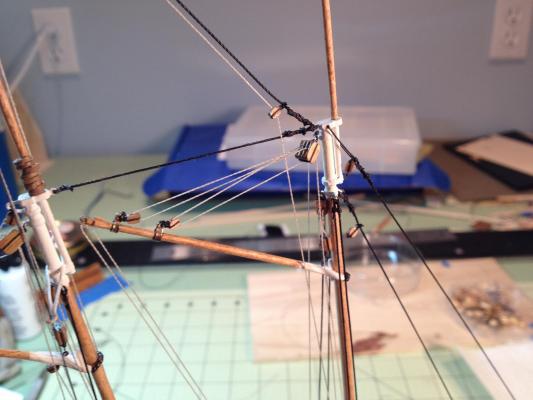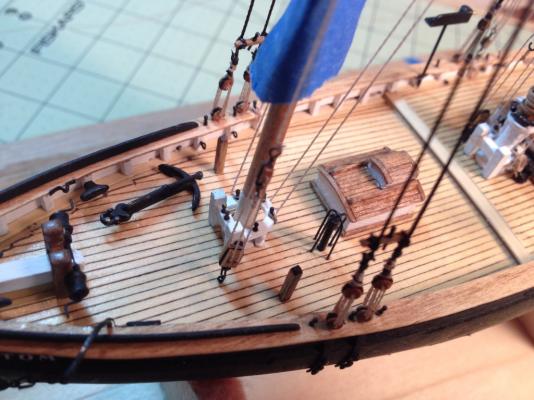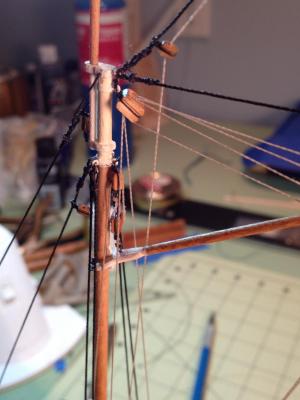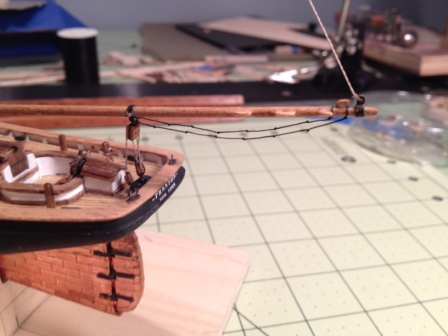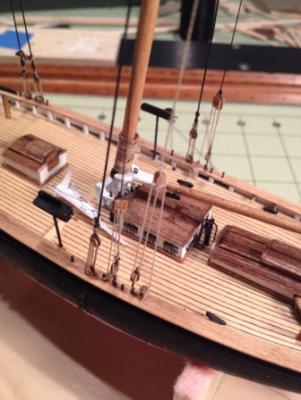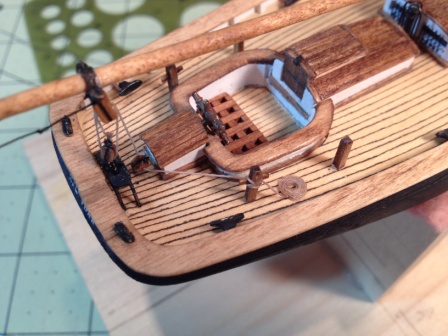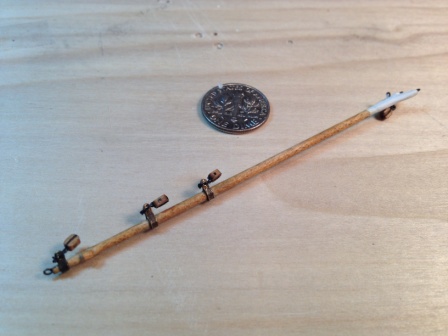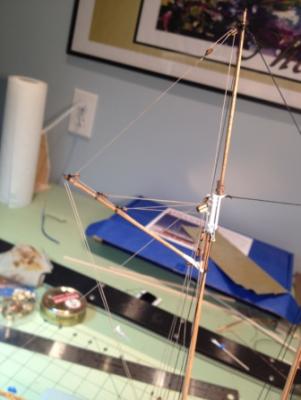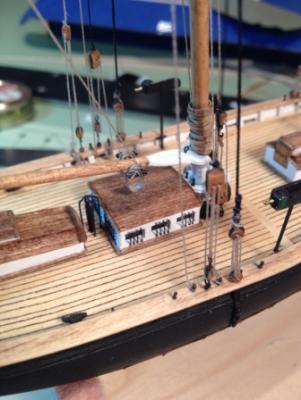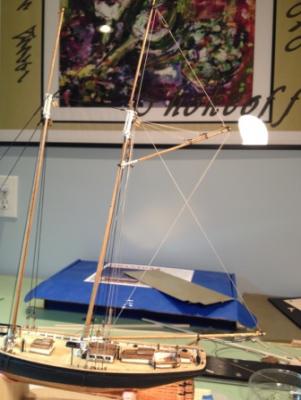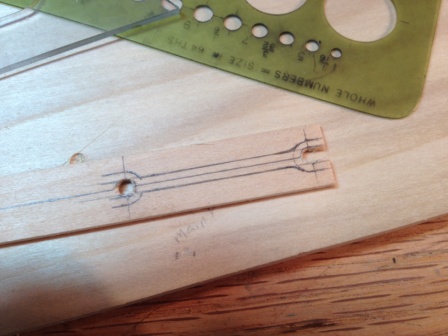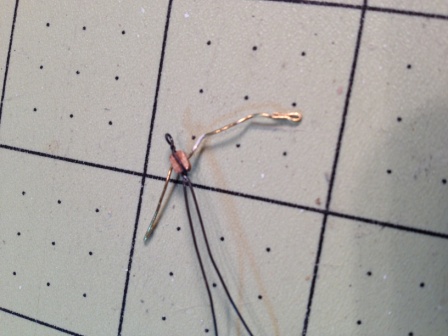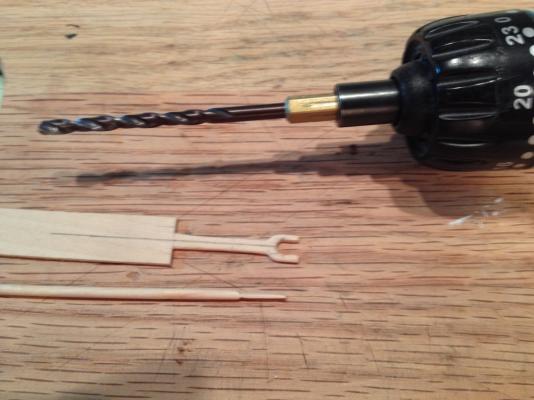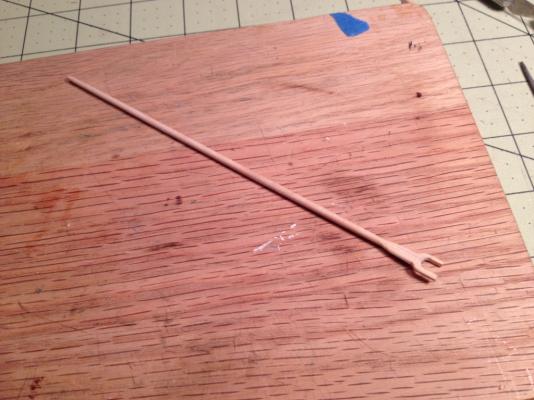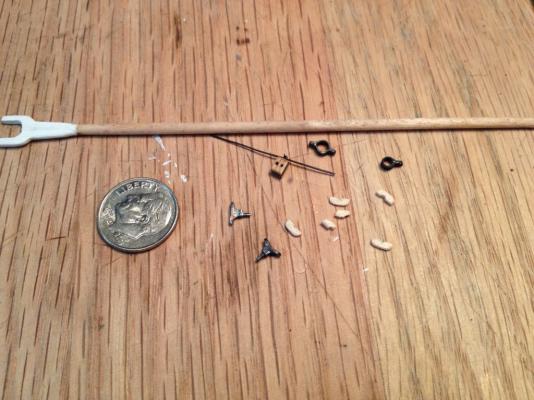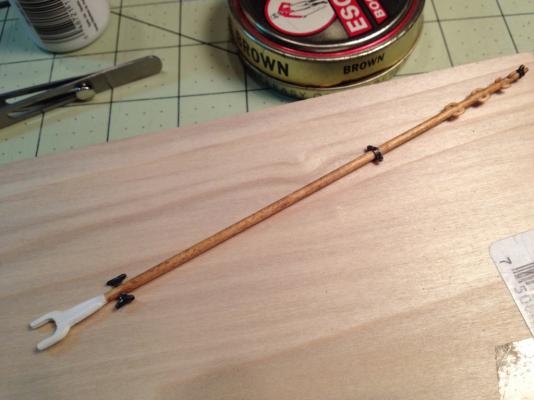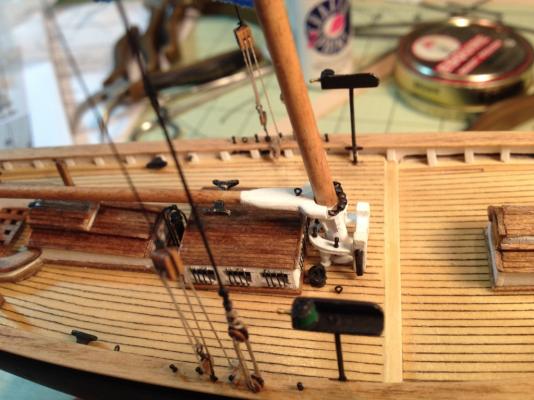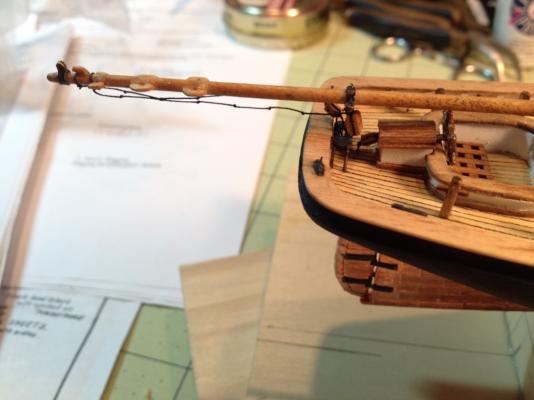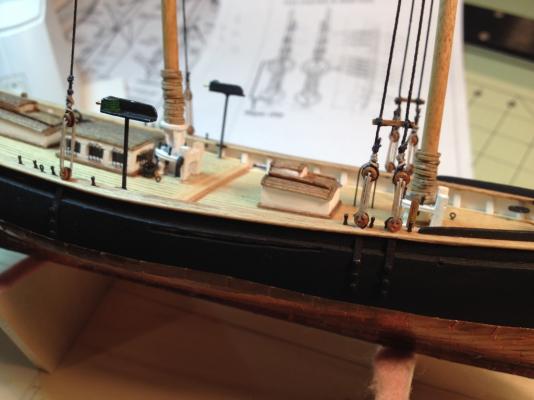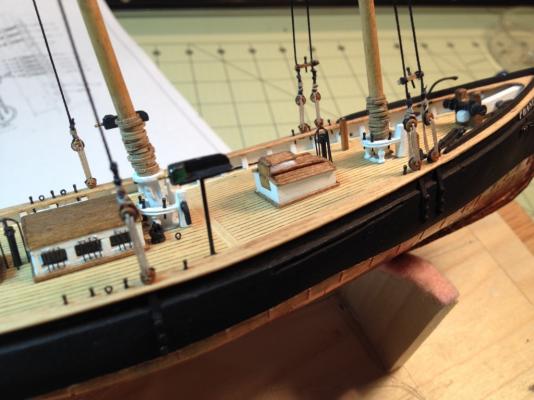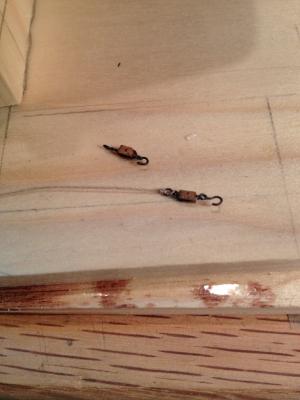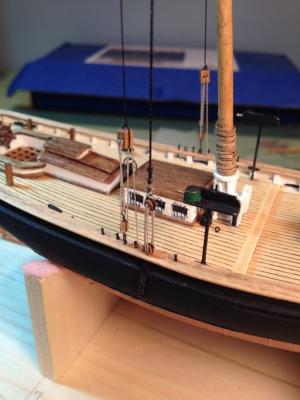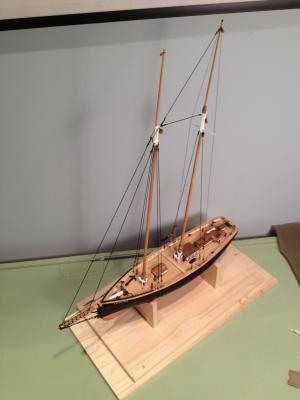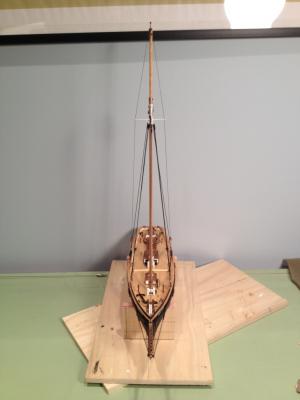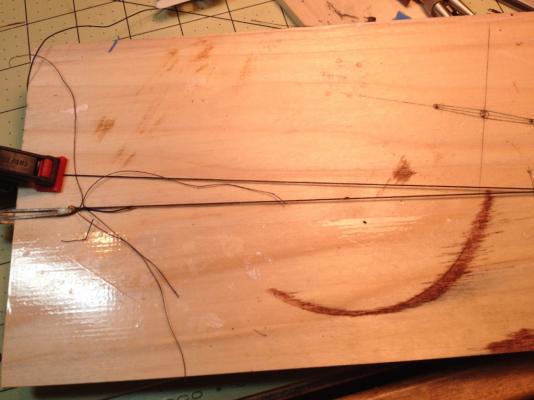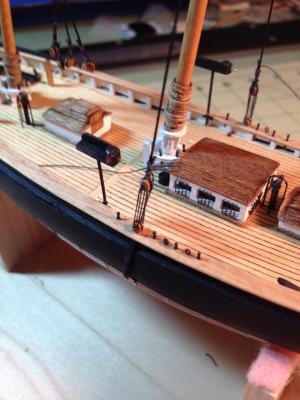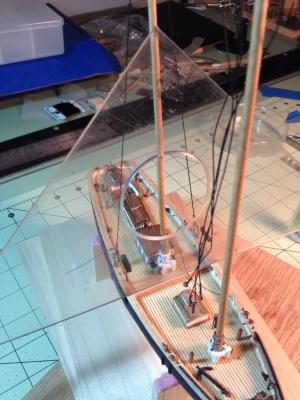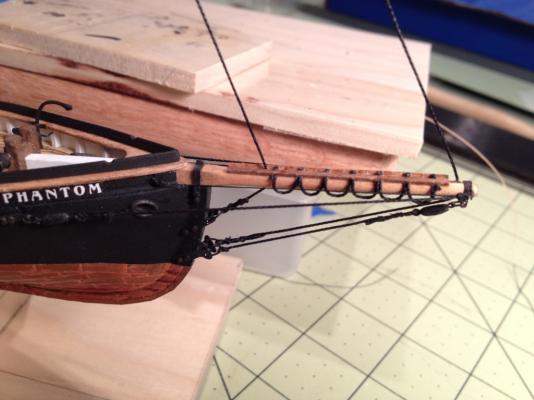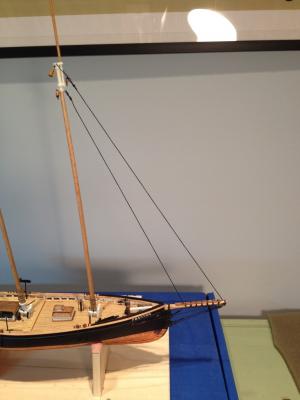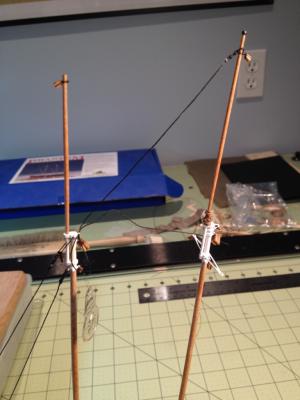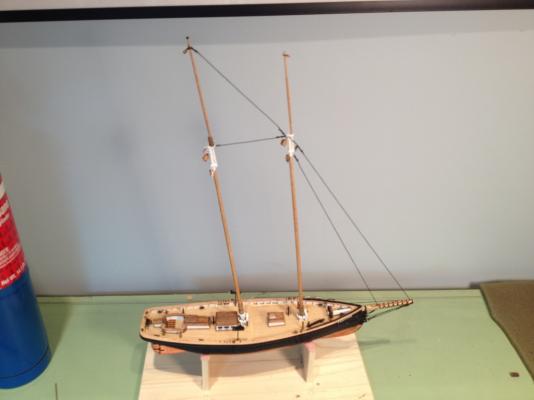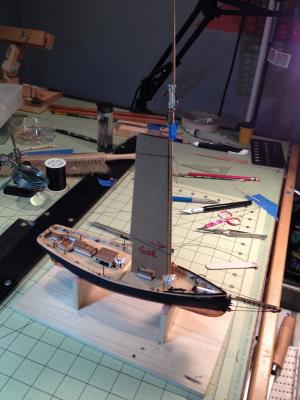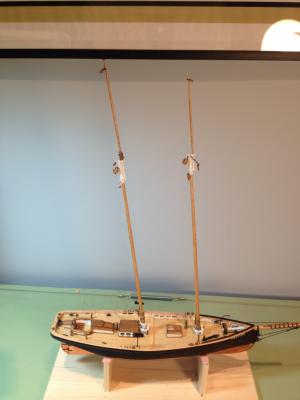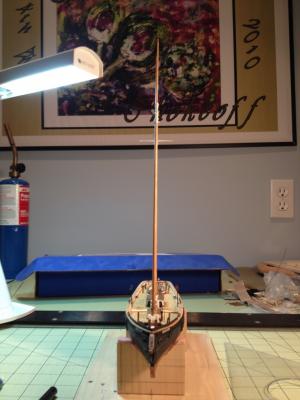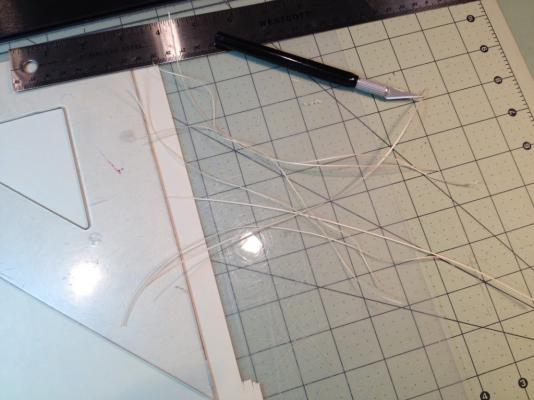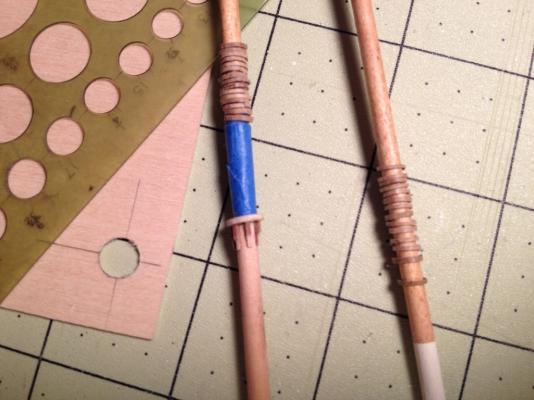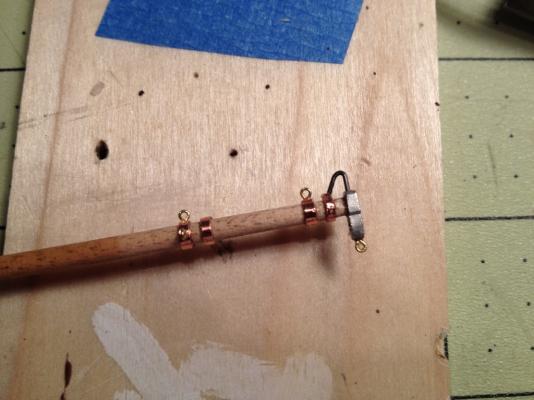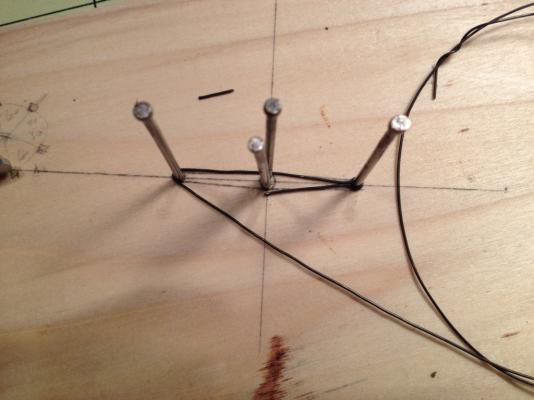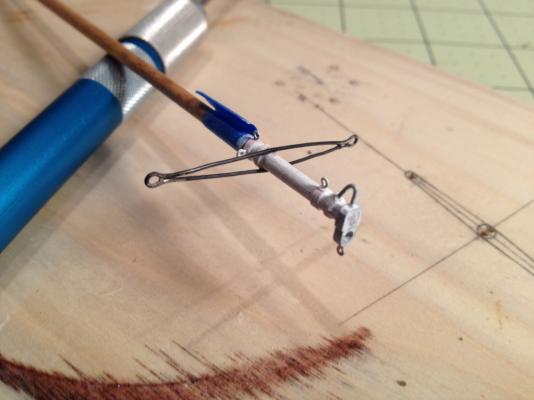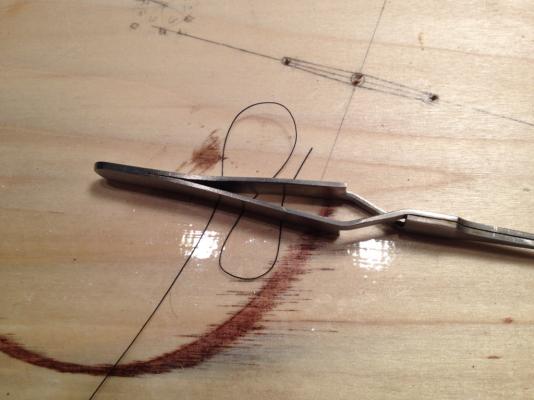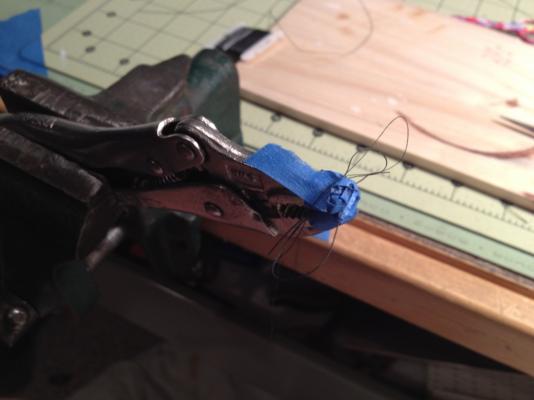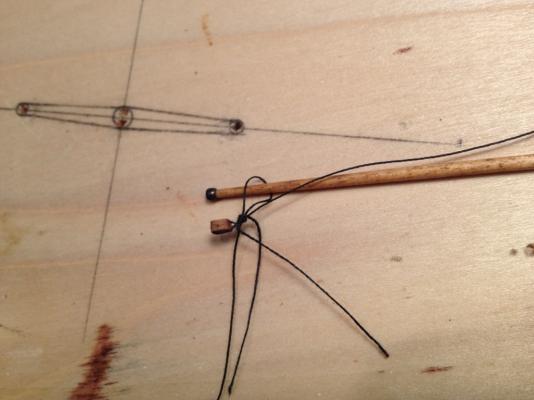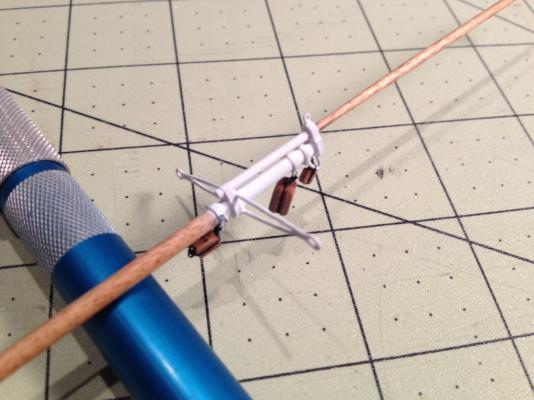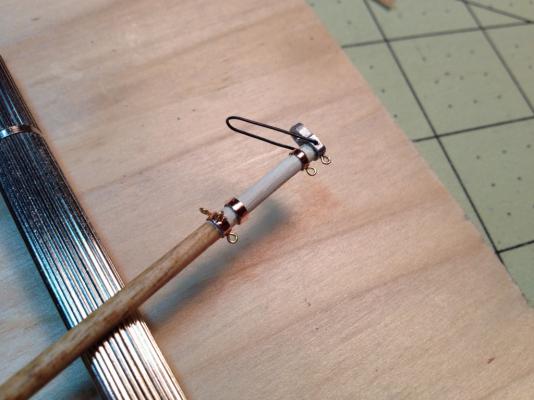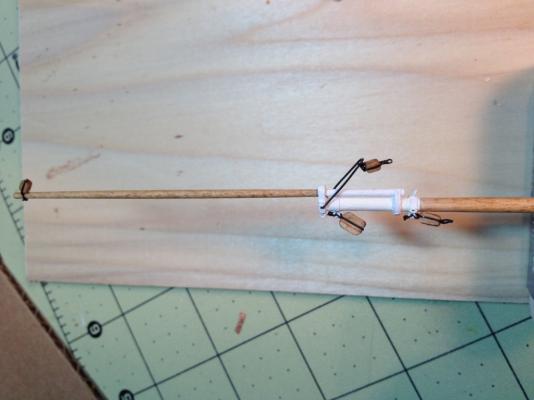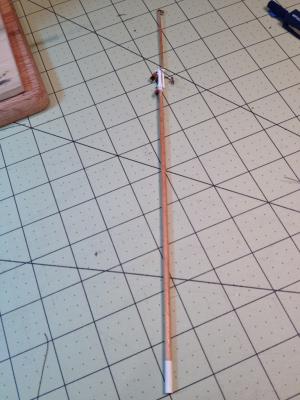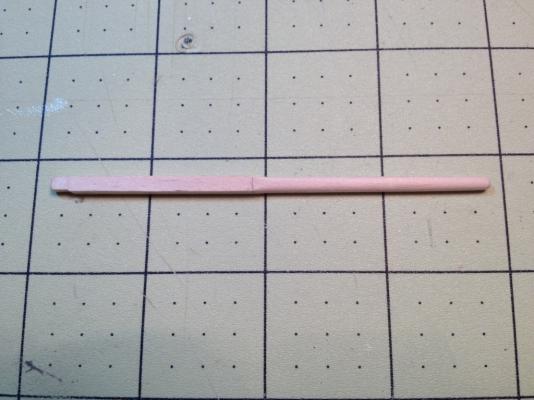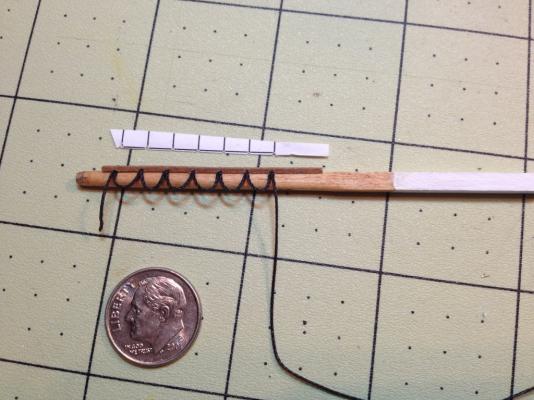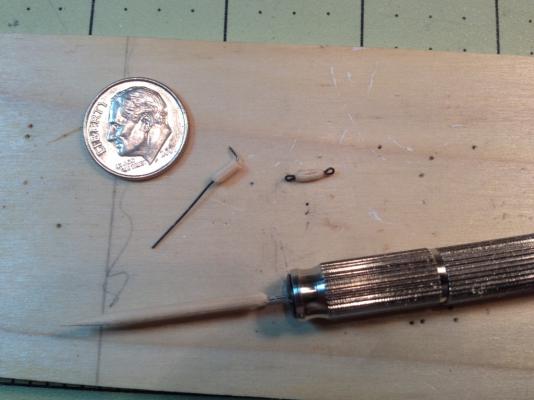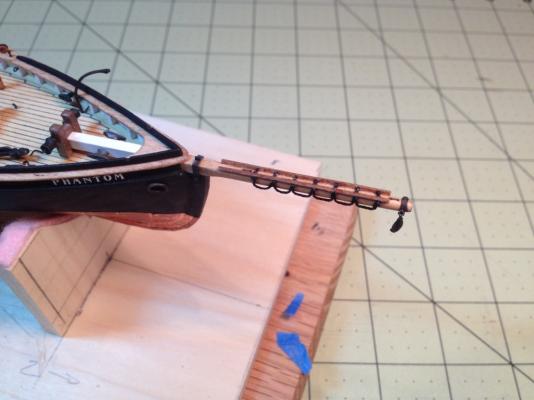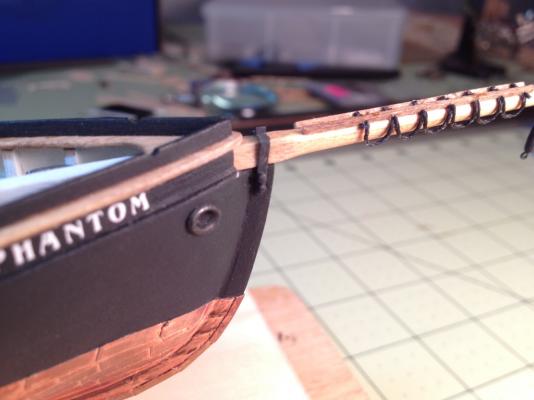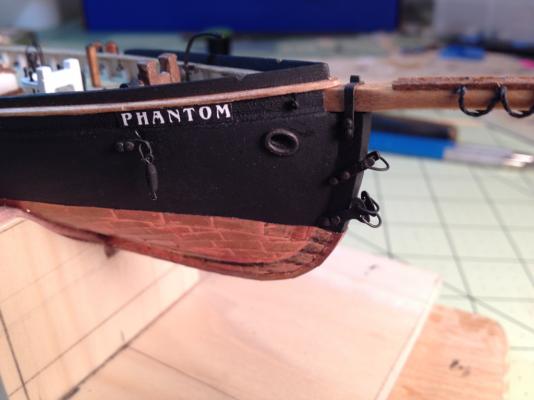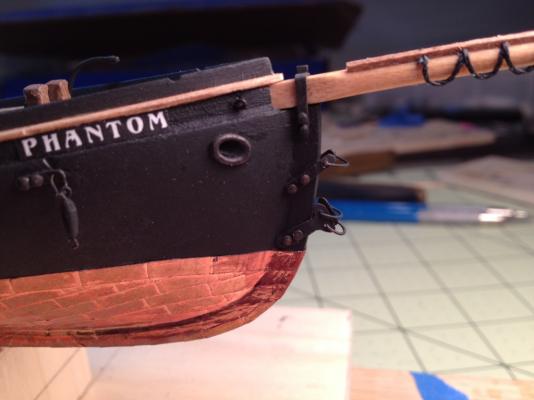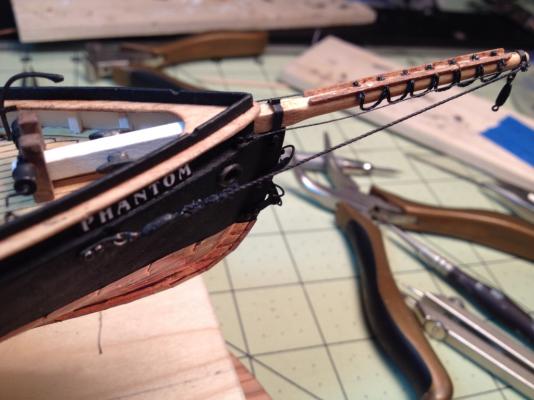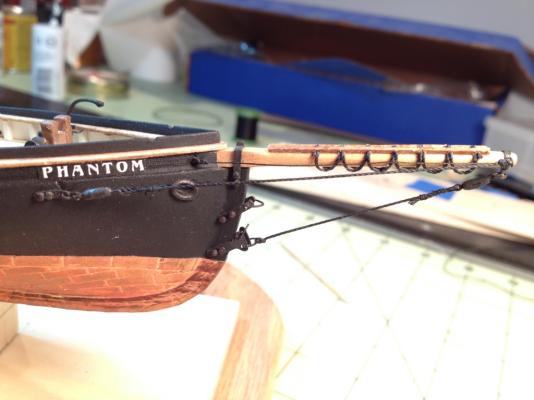-
Posts
803 -
Joined
-
Last visited
Content Type
Profiles
Forums
Gallery
Events
Everything posted by _SalD_
-
Thanks Russ, Things are moving quicker now. Stropping blocks is a lot easier and I’m getting pretty efficient at tying knots with a tweezers. Not quite ready for surgery but I could probably play a mean game of OPERATION now. And where have angled tweezers been all my life, those things are great! I finished the Gaff for the foremast and rigged it to the mast. The rigging was very similar to the Main Gaff. I tried to set the gaffs at the same distance below the mastheads and at the same angle. I am in a bit of a quandary. I'm at a point with this kit where I don’t have much more to do and there is a strong temptation to power through all the remaining tasks for the satisfaction of completing it. But then there is another feeling of dismay that this build will soon be over and I’ll have nothing to do but annoy the Admiral. I could never understand why some people had two or three unopened kits on their shelves, I’m starting to now. I’ll just need to approach the Admiral diplomatically about buying a new kit; “What will it be, a new model or more sex?” ...... I’ll let you know what kit I get.
- 139 replies
-
- phantom
- model shipways
-
(and 1 more)
Tagged with:
-
Main Boom and Gaff I finished the Main Boom rigging by running the topping lift and the Main Sheet Tackle. The installation of these lines was easy enough, so I thought, until I realized I ran the topping lift line through the single block at the top of the Main Top Mast meant for the Topsail Halliard instead of the block at the mast head. Fortunately it was an easy fix since the line was much longer than it needed to be. Main Sheet Tackle Topping Lift Tackle Rope coil Next I worked on the Main Gaff by making the jaws. I decided to make the jaws for the foresail gaff at the same time. The jaws were finished, the iron bands and the cleats were made and everything was assembled similar to the Main Boom. I followed the rigging steps as outlined in the practicum and although it was straight forward enough it seemed like it took me all day to rig this one boom. As I was working on this it boggled my mind how, on a real ship, all these line stay separate and don’t get all tangled let alone how do you remember which line goes with which sail. One thing I did discover after launching another block into the twilight zone while trying to put the stropping on it, was to thread a small piece of wire through the holes so if it did take off I’d have a better chance of finding it.
- 139 replies
-
- phantom
- model shipways
-
(and 1 more)
Tagged with:
-
The Main Boom I started this task by shaping the 6” long dowel that was provided with the kit. I did this by chucking it into my electric drill and shaped it with sand paper to its proper form, similar to how the masts were done. Next I laid out the jaws for the boom on the 1/16”x1/2” wide stock that was provided with the kit. I decided to crave the jaws as one piece and then separate it into two halves. Prior to drawing the jaws on the wood I drilled a 5/32” diameter hole in the wood. This corresponded to the diameter of my mast and gave me a starting point to draw the jaws. Then using an x-acto knife with a number 11 blade, I removed a majority of the waste. I finished shaping the jaws by using an emery board. After I was satisfied with the shape of the jaws I carefully cut the piece in two. I then cut the end of the boom down to fit the jaw pieces. Next I made all the boom attachments. I made the iron bands from the brass strip that came with the kit, the wood stopper cleats were cut from a 1/32” thick sheet, the metal cleats are the ones that came with the kit. The metal cleats looked a bit large so I tried to reduce their size by filing. I think I should have kept filing and made them even a little smaller. I then assembled all the pieces. The double block for the Main Sheet Tackle was tied to a piece of 28 gauge wire which was formed into a ‘U’ shape and inserted through holes drill into each ear of the iron band. The boom was attached to the main mast with parral beads. I raided my daughter’s bead supplies again and found some brass beads (size #0) that were blackened and strung on thread between the two eye bolts on the jaws. Prior to attaching the boom I also tied the foot-ropes at the end of the boom as shown in the practicum. My 'OH SH*T' moment came while I was making the stopper cleats. The day before I had made the iron band for the Main Sheet Tackle and made a mental note that I needed to put the finish on the boom before gluing it on. Well, as I was making the wooded cleats, the next day, I told myself that I should glue these on before I put the finish on. So I glued them on. Needless to say while I was admiring my work and was so proud of how the cleats came out it dawned on me that I didn't have the iron band in place and needed to pull off all the cleats. Fortunately I used white glue and they hadn't set for too long. After that it was cocktail time and no more work for the day.
- 139 replies
-
- phantom
- model shipways
-
(and 1 more)
Tagged with:
-
Brian, Russ, Tom, thank you for checking out my work and the kind words. I would also like to thank everyone for the 'like this'
- 139 replies
-
- phantom
- model shipways
-
(and 1 more)
Tagged with:
-
Brian, Just read through your building log. You're doing a great job. The planking, deck fixtures, and masts look terrific. As a first time builder myself I can appreciate the effort you're putting into it. Keep up the good work. By the way, have you read all those books?
- 119 replies
-
- carmen
- constructo
-
(and 2 more)
Tagged with:
-
Lanyards and Main Topmast Backstays are complete. I wasn't sure how tight to make the shrouds but I didn't put too much tension in them. I had to play with the lines a little to get the deadeyes to line up but persistence prevailed. The Pin Rails with the belaying pin were also tied to the forward shrouds. I need to thank Modeler12 for his tip in one of his posts about applying some ca glue to the end of the lanyard that is inserted through the hole in the deadeye. It made threading the line much easier. I would also like to thank Wayne for his help with the proper way to rig the deadeyes. For the main topmast backstay rigging I started by stropping my block (pardon me if that’s not the correct terminology). I twisted some 30 gauge wire around the single sheave block forming an eyelet on the top and a hook on the bottom. This will be used with the running rigging on the backstay. I then tied the backstay line to the top of the main mast and threaded it down through the outrigger eyelet. Taking a measurement from the rigging plans I located the double block and tied it to the end of the backstay line. Once that was done it was a simple task to reeve the running rigging line through the blocks. One problem I ran into was that after rigging these lines you are suppose to tie it off to a belaying pin in the cap rail. Not knowing exactly how these pins would be used when I installed them I unfortunately placed them to far outboard on the rail so I had no room between the pin and the bulwarks to get the thread in. Fortunately the aft deck scupper was right there so I passed the line out through the scupper and held it in place so I could glue the line to the bulwarks right next to the pin and then brought the line up and around the top of the belaying pin. Then I tried my hand at making rope coils. I think I spend as much time on one coil as I did carving the hull. This one’s too big, this one’s too small, and this one’s unraveling. I never got one that was just right but close enough. I really enjoyed rigging these lines. With the rigging placed on the model I’m starting to get a better understanding of how they all work together. When looking at a fully rigged ship, model or real, it’s hard to visualize where all the lines go and how they work. By doing them one at a time you can see how they brace the masts and how by moving one point on one mast it affects the others. Very structural, I like that. One footnote, I hope there are extra single blocks that came with the kit. While trying to strop the wire around them I did launch a few across the room.
- 139 replies
-
- phantom
- model shipways
-
(and 1 more)
Tagged with:
-
Thanks Wayne. I do have a question. For the lanyards I have found two conflicting ways of doing them. One has the knot in the upper deadeye always starting on the right hand side of the deadeye (port or starboard) looking outboard. The other way has the knot starting on the left looking outboard. Is there a proper way of doing it or is either way okay, just be consistent?
- 139 replies
-
- phantom
- model shipways
-
(and 1 more)
Tagged with:
-
Working on the shrouds I'd like to start by begging forgiveness from all my followers as to how I did my shrouds. After hours of deliberation on how I was going to tie the shrouds, my practical nature prevailed and I ended up making the shrouds off the model. First I measured the distance from the eye bolt on the mast to the deadeye on the cap rail where the shroud would go between. From that dimension I subtracted the distance between the cap rail deadeye and the shroud deadeye taken from the rigging plans. This dimension I used to make a jig to tie the shrouds. A single pin was driven into a piece of wood corresponding to the eye bolt at the top of the shroud (can't see it in the picture). Two smaller pins were positioned at the calculated distance away from the top pin corresponding to the location of the deadeye. Two pins were used to keep the deadeye from rotating. I then place a deadeye on the two pins, held down with a hair clip, wrapped the shroud around it and seized the end. I then looped the thread around the upper pin and tied that end off. I made the four, foremast shrouds and then readjusted the length between the pins for the main mast shrouds. To attach the shrouds to the masts I made a small shackle for the two foremast shrouds and for the main mast I opened up the eye bolt and slipped the top loop of the shroud into it, then closed the eye back up. Please forgive me and I promise I’ll try tying the shrouds like I’m suppose to on my next model. Maybe they’ll be a little bigger next time. I then practiced tying the main mast lanyards before attempting the real thing. Using some sewing thread I tied both the port and starboard side lanyards in order to get a feel on how tight to make them and to practice tying off their ends. While doing this I came up with a simple way to help make sure the mast stayed plumb. Using my 45 degree triangle, I scribed a line bisecting the 90 degree angle and perpendicular to the hypotenuse. Oooou… algebra, “when will I ever use this stuff”… little did I know. I then measured the distance between the cap rails at the location of the mast. Dividing that distance in half I marked that distance on either side of the scribed line along the hypotenuse. Then laying the triangle up against the mast and with the two marks at the edge of the cap rail I could see if the mast was pulled to one side or the other.
- 139 replies
-
- phantom
- model shipways
-
(and 1 more)
Tagged with:
-
Ulli, Hello from a fellow Phantom builder. I hope you will enjoy building this kit as much as I am. It’s a challenge but with the help and advice from all the people on this site like Wayne, you should have no problems. I'm a bit ahead of you but I will be following your build with interest. Good luck,
-
As in the practicum the first two lines I installed were the Fore Stay and the Jib Stay. I’m glad I didn’t glue in the Span Iron in place when I installed it because I found it easier to tie the Fore Stay with it swung up out of the way. After I tied the Jib stay I placed a couple drops of CA glue on the Span Iron at the mast cap. The next two lines I installed were the Main Topmast Stay and the Triatic Stay. I noticed that I would need to thread both of these heavy lines through the same eye bolt on the foremast mast cap and thought this might be difficult. What I did was, first I tied the Main Topmast Stay to the top of the main top mast, then, using a needle threader, I pulled the line through the eye bolt on the foremast mast cap leaving enough thread to rig the Triatic Stay also. I then cut the loop that was pulled through the eye bolt giving me the two ends of the Main Topmast Stay and the Triatic Stay. I then seized both ends of each line. Hope this makes sense, picture might help. A WORD OF CAUTION. For all my fellow Phantom builders who blindly follow directions such as myself (well, most of the time) . I started laying out the shrouds and I noticed that the Navigation Lights are going to interfere with the main mast shrouds. These lights were positioned as shown on Sheet 1 of 3 of the kit plans and as shown in the practicum. If you notice, the lights are shown on pages 19, 20, and 25 of the practicum positioned between the main mast shroud deadeye and the belaying pin, just like the plans. Then on page 26 a miracle happens and the lights are now fore of the belaying pin. Did I miss something? Anyway, I removed (carefully) the lights and moved them forward a bit. I’ll just need to cover up the two holes in the deck with a mop or bucket.
- 139 replies
-
- phantom
- model shipways
-
(and 1 more)
Tagged with:
-
Stepping the masts After correcting my booboo on the mast hoops I glued the masts to the model. I decided to glue the masts in lieu of letting the rigging hold them for two reasons. One, when I drilled the mast holes in the deck I didn’t realize at the time that the dowel diameters would be reduced when shaping the masts, so consequentially the holes were a little big. The second reason was for my lack of experience at rigging. I realized (common sense prevailed) that there was no way I would be able to tie all those lines with the masts flopping around. I set the foremast first with the aid of a cardboard template, cut to the appropriate rake angle. I tied the mast to the template to hold it in the fore & aft position, and plumbed it by eye in the inboard-outboard direction. The blue tape on the mast is holding the mast hoops up out of the way. After the glue had dried over night I set the main mast. To set the correct rake angle and to hold this mast in position I tied a temporary string between the two masts where the Triatic Stay goes. I determined the length of this line by measuring it from the plans. I eye balled the mast for plumb in the inboard-outboard direction.
- 139 replies
-
- phantom
- model shipways
-
(and 1 more)
Tagged with:
-
Bart, thanks for looking at my build and for the kind words.
- 139 replies
-
- phantom
- model shipways
-
(and 1 more)
Tagged with:
-
Tom, that's a good idea for the mast loops and I wish I had thought of it last night. I tried doing it that way with just the plain mast but it wasn't working too well so I ended up removing the block at the top of the mast, putting the mast hoops on and then replacing the block. Thanks for the advice though.
- 139 replies
-
- phantom
- model shipways
-
(and 1 more)
Tagged with:
-
Mast hoops.. Cut strips of manila folder as in the practicum to make the mast hoops. Stained the strips and cut then into ~3/4” long pieces. I found that one of my dremel collets was the right diameter for the mast hoops. I wrapped the strips around the collet and glued the ends together. I made enough for the fore and main masts and waited to make the ones for the top main mast until I knew the correct size. Main Mast.. I shaped the main mast by chucking a dowel into my drill and used sandpaper of different grades held between my two fingers. It does get hot. The boom rest was made using a sheet of 1/32” basswood and a circle template. Drawing a set of centerlines on the wood sheet, I first cut out the hole for the mast by using the circle guide that was a bit smaller than the diameter I needed. Using a compass point held in my mechanical pencil I slowly followed the circle guide until the point carved its way through the wood. I then used a larger circle guide to cut the outer diameter of the boom rest. This guide was a little larger than I needed. The wood washer was then filed to fit the mast. The six chocks below the boom rest were made from 1/32” square stock and tapered by filing. The boom rest was angled per the plans and glued into place. The six chocks were then attached. The iron bands and eye bolts were assembled similar to the foremast. The ‘V’ shaped iron that is at the top of the mast was made from 22 gauge wire. Holes were drilled into the mast cap and the top iron band the iron ‘V’ was glued in. It might be worth repeating from the practicum but make sure you put the mast hoops on before placing the mast cap and iron bands on. The iron outrigger was formed on a little jig using finishing nails. I sketched out the basic shape of the outrigger on a piece of wood, getting the dimensions from the elevation view shown on the Rigging Plan drawing. I wrapped the 22 gauge wire around the nails and then pinched the ends with a needle nosed pliers to form the eyelet for the topmast backstay lines. After doing this I felt that the nail diameter I used for the eyelet was a little too big so I made another outrigger using a smaller diameter nail. I don't have a picture of the second jig. I finished the outrigger by soldering the ends together to form the eyelet. The outrigger was then glued to the mast, checking for level in each direction. Everything was then painted white. I made the main topmast exactly like the top foremast. The top mast was placed through the mast cap and secured with and iron band around it and the main mast. The appropriate sized blocks were tied to the eye bolts (getting a little easier). For the block that is stropped to the top of the main topmast I decided to try the method I found in the forum ‘Rigging Blocks – How to’, a video post by Modeler12, ‘Rigging a block to a mast or Spar’. I don’t have (it’s been ordered, don’t tell the Admiral) a hemostat so I improvised using my small vise grips. The method worked well and got it on the first try. The ball truck at the top of the mast was confiscated from my daughter’s jeweler making kit. She’s back at college so no begging was required. It’s a small brass bead that was blackened and fit perfectly onto the mast. As I am writing this though I am kick myself in the ***. I just realized that I forgot to put the mast hoops on the top mainmast even though I read ahead in Chuck’s practicum where he did the same thing and cautioned against it. I guess we’ll see how I do with re-dos.
- 139 replies
-
- phantom
- model shipways
-
(and 1 more)
Tagged with:
-
Nils, Thank you, I'm glad you like the colors.
- 139 replies
-
- phantom
- model shipways
-
(and 1 more)
Tagged with:
-
Eddie Thank you for the more than kind compliments. Although this is my first attempt at building a model ship I have built other models in the past. I've spend the last few years, on and off, putting together my HO trains that I've had in storage for the past thirty or so years. I will post a few pic's in the 'What else do you model, besides ships?' forum for anyone interested. I had most of the tools so there wasn't a big investment needed to try my hand at ship building. I’m sure with your engineering background and model plane experience you should have no problems working on a model ship. As far as the Phantom kit is concerned, it is rated as “entry” level but I would use that term lightly. If it wasn't for Chuck Passaro’s practicum and the advice received from the more experienced modelers on this site I would be lost. I had also thought about trying a more advanced model for my first kit but chose this kit, 1) because it was rated as “entry” level and 2) the price. I wanted to make sure I was going to be committed to this hobby before I invested a lot of money into a kit. The Phantom’s scale (1/8” per ft.) is very small however; a little larger ship would go easier on the eyes. Whichever ship you choose, I’m sure you’ll do a great job.
- 139 replies
-
- phantom
- model shipways
-
(and 1 more)
Tagged with:
-
Wax on, wax off, and sand 'd floor... But alas I'm afraid if I were to come my wife would immediately turn my workshop into a coupon clipping center. She is however upstairs at this very moment packing my suitcase. Maybe 40 years ago I would have taken you up on the offer. Best regards,
- 1,207 replies
-
- sloop
- kingfisher
-
(and 1 more)
Tagged with:
-
Remco I’ve just found your building log and have just finished going through all your posts. What can I say that everyone else hasn’t said already? Absolutely magnificent! Superb craftsmanship! If you ever feel the need for a lowly apprentice just say the word and I’ll catch the next flight to the Netherlands. Truly wonderful work
- 1,207 replies
-
- sloop
- kingfisher
-
(and 1 more)
Tagged with:
-
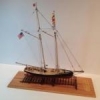
Dewalt 788 Scroll Saw Steal
_SalD_ replied to FlounderFillet5's topic in Modeling tools and Workshop Equipment
Nice find Max, Right place at the right time. Now I'm jealous -
To glue, or not to glue? I've assembled my first (fore) mast which went smoother than anticipated. I started by shaping the lower foremast by using the method described by Dziadeczek in the ‘How to Taper Masts’ post by using two paint stirring sticks. I glued the sandpaper to one side of each stick and set the taper between the sticks as per the plans. I then chucked the dowel in my portable drill and fed the dowel in between the two sticks. One problem I had was that the paint sticks seemed to be too flexible and the top stick tended to bow upward as the dowel was inserted. I used a sandpaper with a 220 girt which may have been to fine for this application. I finished shaping the mast by holding a piece on sandpaper between my fingers and running it along the dowel while spinning it with the drill. After shaping the mast I squared off the top to fit the mast cap but did not glue it in place. I then painted the top and bottom white. For the mast bands I decided to use some of the left over copper tape used for the hull. I had seen this in craigb’s Phantom build log and thought it was a good solution. I cut the tape lengthwise into 1 mm wide strips and wrapped them around the mast. Next I drilled the holes in the bands for the eye bolts and glued them in place. I decided to position the eye bolts for the shrouds 90 degrees from what was shown in the practicum. I did this because after having a difficult time threading the thin foot-rope thread and thicker bowsprit guy thread through the same eye bolt I didn't think I would ever get the two thicker shroud lines through the same hole. Instead I will attach the two shrouds to a shackle and insert the shackle through the eye bolt. Before gluing the mast cap to the mast I drilled the holes for the span iron and eye bolt. After gluing the mast cap in place I glued the eye bolt into it but not the span iron. I will leave this free to move and will glue it in place after I rig the jib stay line to get its proper angle. I then painted it all white. Next I chucked the dowel for the top foremast into the drill and shaped it by holding sandpaper between two fingers. At this point I tied all the blocks to the individual masts. I thought it would be easier to do each mast separately then when they're combined. I still find tying these very difficult. Don’t know if it’s just lack of experience; or my fingers are too big; or I can’t see too well anymore, probably a combination of all three. In spite of my short comings I attached all the blocks. I then inserted the top foremast through the mast cap and wrapped the bottom with more copper tape. Finished by touching up the paint. Now back to my original question. Chuck’s practicum says to glue the mast to the model, but the directions that came with the kit recommends not gluing the mast and using the rigging to hold it in place. I was just wondering what the general consensus is on this. So, to glue, or not to glue, that is the question.
- 139 replies
-
- phantom
- model shipways
-
(and 1 more)
Tagged with:
-
Russ, thanks for the tip. I'll give it a try next time. Michael, for an "entry" level kit it can be quite a challenge.
- 139 replies
-
- phantom
- model shipways
-
(and 1 more)
Tagged with:
-
The bowsprit.. The bowsprit was made from the 1/8” square stock that came with the kit. Took the length from the plans and shaped the rounded portion by first carving the corners off and then using my portable drill as a lathe and some sandpaper to finish rounding it. I drilled the two sheaves as described in the practicum. Next I cut and glued the two jackstays to the bowsprit also as described in the practicum. A template was made to locate the holes for the gaskets. I decided to try and use the heavier rigging thread for the gaskets instead of the 28 gauge wire. This is kind of hard to explain (should have taken a picture) but using just the wire from a needle threader, I first laid the thread in the threader, I then inserted the two loose ends of the wire through the bottom of the hole in the jackstay and pulled the thread through the hole a tiny bit, just enough to slide the wire off the loop. I continued this for each hole trying to keep the loops as equal as possible. Then repeated the procedure on the other side. For the iron band at the outboard end of the bowsprit I made a brass band using the technique described in the Ear'd Bands - Masts, Booms, etc. post by azzoun. After making the band I temporarily positioned it on the bowsprit and drilled two holes on either side of it for the eye bolts. The stretching screws were made similar to what was described in the practicum. First I drilled a hole through the toothpick, then I cut the toothpick to the length of the screw; I used 3/16”. Next I shaped the screw with an emery board, inserting a wire through the hole to make it easier to handle. Once the shape looked somewhat reasonable I glued the eye bolts in each end. Three of them were made. Once all the pieces were either blackened or painted the bowsprit was installed. I attached the iron band and glued in the outboard eye bolts and attached the stretching screw. I then made the gammoning iron out of brass and positioned it around the bowsprit and connected it to the stem post. I also glued the two cleats to the inboard end of the bowsprit whose holes I had previously drilled. Next I decided to try and replicate the iron fittings at the bow of the ship for the bowsprit guide, bobstay, and jib and fore stays. I cut the pieces out of brass and filed them to a size I thought was appropriate. To install the pieces I drill small holes in the stem post and hull and inserted nails similar to what was done for the chainplates. The remaining stretching screws were connected to the bowsprit guy fittings on the hull and small shackles, made from 28 gauge wire, were insert in the bobstay fitting. I then tried my hand at tying my first rigging line. The footropes were simple enough, tie two knots, done. Then I tried the bowsprit guide, OMG, whose idea of fun is this anyways, the Marquis de Sade! One thing for sure, I now have much greater respect and admiration for all the model makers who do all that rigging. After numerous attempts I was finally satisfied with how the bowsprit guy looked. I’m not sure if the way I did it is "historically accurate" but in order to keep my sanity this is how I did it. I first tied the rigging line to the eye bolt at the outboard end of the bowsprit using a simple knot. I then threaded the other end of the line through the stretching screw and pulled it taut. Keeping the line taut with an alligator clip holder I seized the end closed (being a glutton for punishment I figure why not try tying tiny knots while I’m at it). I seized the line in two places, securing the knots with a little glue. I did this for the other bowsprit guy and the bobstay. I figure, as soon as I grow three more hands I should be able to do this with some amount of proficiency. One question I have is that after I trimmed the line my ends were frayed. Is this normal or is there a way to prevent this from happening or fixing it?
- 139 replies
-
- phantom
- model shipways
-
(and 1 more)
Tagged with:
About us
Modelshipworld - Advancing Ship Modeling through Research
SSL Secured
Your security is important for us so this Website is SSL-Secured
NRG Mailing Address
Nautical Research Guild
237 South Lincoln Street
Westmont IL, 60559-1917
Model Ship World ® and the MSW logo are Registered Trademarks, and belong to the Nautical Research Guild (United States Patent and Trademark Office: No. 6,929,264 & No. 6,929,274, registered Dec. 20, 2022)
Helpful Links
About the NRG
If you enjoy building ship models that are historically accurate as well as beautiful, then The Nautical Research Guild (NRG) is just right for you.
The Guild is a non-profit educational organization whose mission is to “Advance Ship Modeling Through Research”. We provide support to our members in their efforts to raise the quality of their model ships.
The Nautical Research Guild has published our world-renowned quarterly magazine, The Nautical Research Journal, since 1955. The pages of the Journal are full of articles by accomplished ship modelers who show you how they create those exquisite details on their models, and by maritime historians who show you the correct details to build. The Journal is available in both print and digital editions. Go to the NRG web site (www.thenrg.org) to download a complimentary digital copy of the Journal. The NRG also publishes plan sets, books and compilations of back issues of the Journal and the former Ships in Scale and Model Ship Builder magazines.


